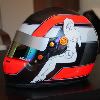richard_leeds wrote:
The dimensional limits only apply when stationary. All parts of the car move and deflect under loading - unless they are infinitely stiff. There is an allowable deflection defined by a load test. RB pass that test. RB comply with the rules.
Cars frequently bottom out, are you advocating prohibition of that too?
If you had read me, you would have known I am NOT talking about the bending test, which the wing passes.
I am talking about a rule that says no aerodynamic device should be designed as an attempt to bridge the gap to the ground (it's the rule that outlawed skirts). And it is forbidden to do so
under any circumstances. I believe a running car is a circumstance, right? So it's included under "any circumstances".
The second rule it breaches is the "no part should be under the reference plane" rule. Again under any circumstances.
So go and read the complete text of technical regulation 3.15, and maybe then we can talk.
Lindz wrote:
-You can't DQ a car because you see pictures of it doing something 'illegal'. You have tests to deem what is and is not illegal. If the car or parts pass this test... well, then what? You say it's legal in real-life testing, but illegal in pictures?
-When in motion under racing conditions, you are contending with unpredictable (or at least unverifiable) forces of nature. How do you test this? Again... you cannot DQ a car because of photographs (or even video).
Why not? Photographs are admissible evidence in criminal cases, why should F1 refuse such evidence? They are perfectly acceptable evidence if used in the correct way, and reverse engineering a shape from a photograph is not very difficult.
When the rule says "under any circumstances", that takes into account the "forces of nature" you're talking about. Photographic evidence should be accepted under such conditions. That's really up to the Stewards and to Whiting at the end of the day.
As for redesigning the test, there are ways of doing that in a better fashion than what they did last time (they just increased the load to a value still under the real aerodynamic load experienced by the wing).
Having a multi point load test would sort this (load three points along the endplate), using the same rig as they are using right now, so no extra cost and no delay for building a new rig.
Also, right now, the test is done with the middle of the wing fixed, so it doesn't allow for measuring nose flexing. They should use the plank as the fixed part instead, as this would allow the nose to flex in the test without taking suspension travel into account.




